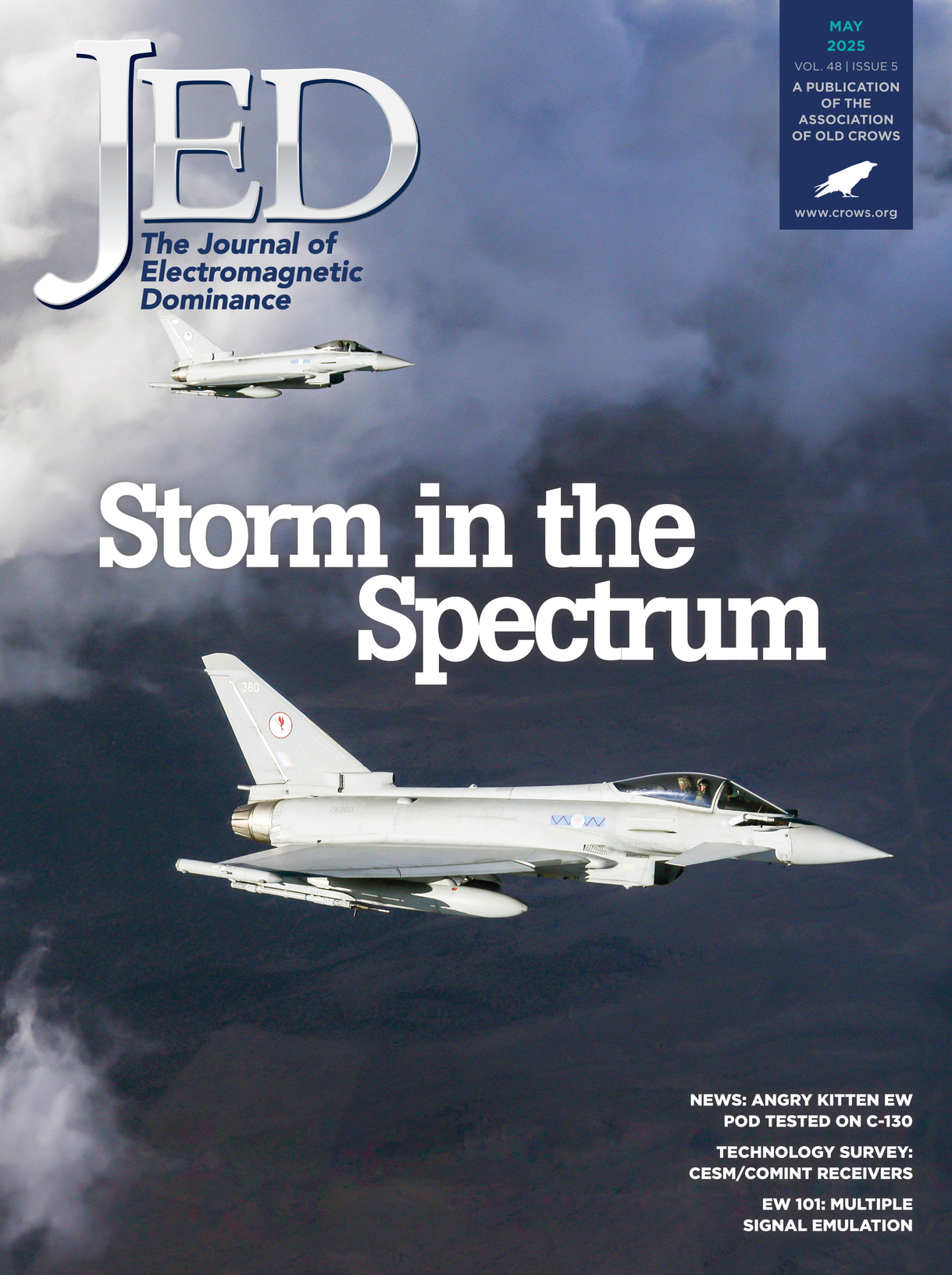 |
||||||||||||
| Archive | Subscribe | Crows.org | JED Resource Guide | WWW.JEDONLINE.COM | ||||||||||||
|
From the Editor
AOC Europe 2025 provided attendees with many excellent insights into EW lessons from the Russo-Ukrainian War, emerging operational concepts, NATO challenges and cooperation, and new technologies, such as AI and quantum. The week opened with Plath Intelligence Day, which focused on multi-domain autonomous intelligence and real-time intelligence, data fusion and adaptation. Senior leaders from Plath discussed the need for military forces, as well as industry, to embrace change and adapt to the faster pace of military operations; invest in new SIGINT capabilities rather than outdated technologies; and to cooperate more intensely – not only between companies but also between nations. Admiral Davide Berna, former commander of Italy's Joint Intelligence Center, told attendees that the multi-domain operational picture is extremely complex. He urged the audience to "embrace innovation" and observed that innovation is not just technological, but also a state of mind that can improve processes and yield new concepts. Maj Gen Enrico Pederzolli, ITAF, commander of Italy's Joint Intelligence Center, said one of his command's biggest challenges is to collect multiple types of intelligence (including SIGINT) across multiple domains. Another challenge is to rapidly deliver this intelligence to weapons systems, potentially by developing secure combat cloud-type solutions. On Day 1 of the AOC Europe Symposium, Lieutenant General Angelo Gervasio, Technical Advisor to the Chief Head of Defence, Italian Armed Forces Joint Staff, told the audience about the spectrum policy challenges that the Italian armed forces, like many others in Europe, are facing due to the spectrum needs of commercial applications, such as 5G communications. He also addressed the centrality of the EMS in linking together the air, land, sea and space domains, as well as the importance of recognizing the EMS as a warfighting domain. Lieutenant General Luca Goretti, Italian Air Force Chief of Staff, told the audience that new technologies are useful but that people remain essential for conducting successful operations. He said that learning how to operate weapons systems and share data in a timely manner are what's most important and also what are the most difficult aspects of air operations. The ability to share lots of data – about threats and targets – across multiple air platforms creates a "mosaic effect" that makes it extremely difficult for an adversary to prioritize which nodes to attack. One of the major themes of AOC Europe was space operations. The Russo-Ukraine War, for example, has highlighted how both sides rely on satellites for PNT signals, satellite communications and command and control of long-range weapons. In a session themed "Dependence on Space for EW Operations" Major General Michael Traut, Commander, German Space Command, discussed the many ways the space domain is becoming a warfighting domain, exemplified by the ways that Ukraine and Russia are using and attacking space platforms and jamming space-based signals. One interesting aspect he mentioned was situational awareness and self-protection for constellations of satellites – potentially including threat warning sensors and electronic countermeasures. Another theme throughout the week was how European nations, as well as NATO, can speed up its innovation cycles closer to what Ukraine and Russia are achieving on the battlefield – timeframes of 6-8 weeks instead of months and years. One session that focused on this concept was the "NATO Special Session: Bringing to Life the High/Low Mix for NATO MDO." One of the messages from this session was about NATO's need to utilize and adapt the EW capabilities it has today rather than delaying decisions and waiting for new EW capabilities and weapons platforms to be procured and brought into service several years in the future. One way to leverage current capabilities in new ways is to focus on EW command and control. Another way to speed innovation is to move away from requirements documents and bring the EW industry into the development process at much earlier phases than at present. Referring to the session theme, one speaker said, NATO must figure out what its high/low mix needs to be for EW. What types of expensive, exquisite, high-end EW capabilities does it need and how can it complement these with large numbers of less expensive, rapidly acquired EW capabilities that can overwhelm an adversary's C2 capabilities. – JED Staff
Inside the Convention
The second day of AOC Europe opened with a briefing from Commander Malte von Spreckelsen, Deputy Branch Head for Strategic Planning within the Cyber and Information Domain Service of the German Armed Forces. In his talk, he discussed some of the lessons European nations are taking from the Russo-Ukrainian War, as well as providing more details about the Electromagnetic Warfare Capability Coalition established in April by the Ukraine Defence Contact Group (UDCG). Commander von Spreckelsen said the Russo-Ukrainian War has shown the value of Electromagnetic Spectrum Operations, especially with regard to drones; EW protection from jamming; emitter targeting; and missile defense operations that include GNSS jamming. On the other hand, Ukrainian Forces have also learned hard lessons about electromagnetic fratricide and the need to coordinate EW operations between units operating on the front lines. The electromagnetic fratricide issue is due in part to the number of commercial drone technologies employed by both Ukrainian and Russian forces that often use the same limited sets of frequencies. Thus, jamming a Russian drone can sometimes affect Ukrainian drones operating in the same areas. Commander von Spreckelsen said another problem for Ukrainian Forces has been EM interoperability, which stems from the variety of EW, communications and radar systems provided to Ukraine units from other countries. "A lot of companies, lot of nations, donated EW systems, donated capabilities which are good," he explained. "They are brought to the front line; they get used; they have a purpose. However, a German system might be not interoperable with a Swedish system, [or] with an Italian system. This is a challenge we have, as well, in NATO – to try to bring a multinational EW force under the umbrella of NATO or the EU together and have interoperability on the first day – it will not match." Commander von Spreckelsen also provided more details about the EW Coalition established under the UDCG. Ten nations signed the joint letter of intent that established the EW Capability Coalition, with Germany acting as the lead nation and coordinator in the group. He emphasized that Ukraine is not the "receiver" of the group's activities, but rather that all 10 nations are equal partners, and Ukraine is an active participant that is sharing its first-hand knowledge and experience from the front lines, as well as testing and evaluating new systems in "live fire" conditions. He also explained that the EW group is a "coalition of the willing" and is open to adding new members among the 50 nations participating in the UDCG. The EW Coalition is initially focusing its efforts on three priorities, with each of these falling under a "sub-working group." The first priority is aimed at rapidly procuring new EW capabilities for Ukrainian forces. The sub-working group for this priority is discussing the EW capabilities already identified by Ukraine in a white paper. It will use this discussion to identify specific EW systems that the coalition members can provide to meet those capability needs. For example, he said, one of the top priorities Ukraine identified is defending drones against jammers. A second sub-working group is addressing EW training and education. "They don't need to train in the basics of EW," he explained. "They are very good at it. They don't need to [receive] an awareness briefing that when you switch on your cell phone you might get hit by a shell." He said the Ukrainian forces are already very good at "frontline EW." Instead, he continued, "What they need is training of leadership – is education on an academic level. They want to train and develop expertise for EW because, as I said before, they want to enhance their innovation cycle. They want to be in the position to push forward, to work, to invent their own [EW solutions] which [are] fit for purpose. And they need access to our universities, to academia, to all of us to gain knowledge to sustain [themselves] in this conflict." The EW Coalition's third sub-working group is focused on policy and doctrine. "The capability coalitions are not just made to support ad hoc problems – to deliver materiel. This is an ongoing thing, a long-term thing, because if this conflict ends one day – hopefully soon – they want to involve [themselves in EW] further. They want to know how to integrate the EW forces into brigade level, corps level. They want to know how to [conduct] EW command and control, how to [support] electromagnetic operations like [other European nations]. They want to be interoperable with us. They want to have at the end, in peacetime, very capable EW forces. For this they need our help." – JED Staff
JED News
Read the May issue of JED Cover Story: Storm in the Spectrum: Typhoon in Line for Next-Generation EW Capabilities The Journal of Electromagnetic Dominance (JED) is the official publication of the Association of Old Crows (AOC), an independent, nonprofit, international professional association promoting public understanding in the science and practice of EW, SIGINT and related disciplines. Become an AOC member to get access to the latest issue of JED. Digital Pub Bin
Check out current issues and news from our media partners throughout the week. JED |
||||||||||||





